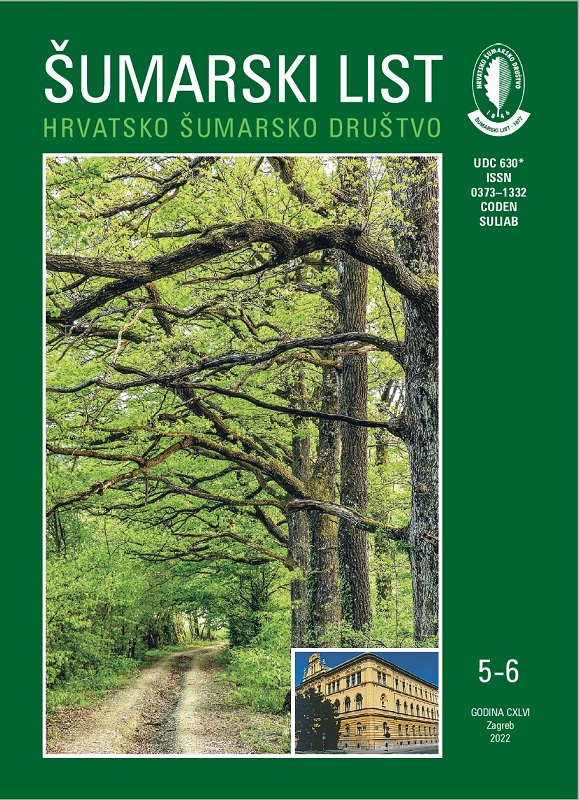
broj: 5-6/2022
pdf (11,37 MB) |
|
||||||||||||||
| RIJEČ UREDNIŠTVA | ||
| Uredništvo | ||
| XV World Forestry Congress pdf HR EN | 173 | |
| IZVORNI ZNANSTVENI ČLANCI | ||
| Krunoslav Sever, Davor Poljaković, Tomislav Karažija, Boris Lazarević, Antonia Vukmirović, Mario Šango, Željko Škvorc | UDK 630* 815 + 847 (001) https://doi.org/10.31298/sl.146.5-6.1 | |
| Growth of common beech (Fagus sylvatica L.) saplings under the impact of suboptimal mineral nutrition pdf HR EN | 175 | |
| Jelena Kolić, Renata Pernar, Ante Seletković, Mirna Samaržija, Mario Ančić | UDK 630* 533 + 535 (001) https://doi.org/10.31298/sl.146.5-6.2 | |
| Comparison of crown damage assessment on analog and digital infrared color (CIR) aerial photographs pdf HR EN | 187 | |
| Matija Landekić, Ivan Bošnjak, Matija Bakarić, Mario Šporčić | UDK 630* 309 (001) https://doi.org/10.31298/sl.146.5-6.3 | |
| Trends and relations of occupational safety indicators in Croatian forestry pdf HR EN | 201 | |
| Summary Forest harvesting, especially motor-manual felling and processing is a high-risk work process where a chainsaw is a key source of danger. Consequently, the main goal of the research is to determine the work potential for quality and safe work of chainsaw workers compared to the achieved average score of work technique. The second goal is related to the recognition of shortcomings and critical elements in work technique as a place of necessary corrections and improvements, and thus the improvement of the safety culture in forestry. The third goal of the research refers to the analysis and comparison of selected safety indicators at the level of the company Hrvatske šume Ltd., the belonging economic activity defined according to the national classification and the state of the Republic of Croatia. A total of 10,253 grades for 11 elements of work technique (Table 2) allocated in the period 2014-2018, and selected indicators of safety at work at the level of company – economic activity – state for the period 2014-2020, were entered into the database for further processing. Descriptive and inferential statistics techniques were applied in data analysis. Average scores by working elements for the five-year period range from 2.65 to 2.95 (Figure 2), and the level of work technique expressed by the absolute average score is 2.81 (Table 3), which makes 94% of the total working potential (Pmax). The two best rated elements are the use of personal protective equipment (belongs to the C group of elements) and the pruning quality (belongs to the B group of elements), and critical elements of the chainsaw working technique are identified in Group A such as the look of safety zone (turning point) and establishing and checking of felling direction (Table 4). Analysis of variance revealed a statistically significant difference between the A and C groups of working elements (Figure 3). In the analysis of safety indicators in the period in question at the level of the company Hrvatske šume Ltd. the largest number of accidents (51.35% of all recorded injuries at the workplace) occurred during the forest harvesting phase, i.e., during motor-manual felling (Table 5). The analysed trend of the frequency of work-related injuries in the observed period at the enterprise level does not show a significant improvement, but stagnant values with less significant oscillations between years. On the other hand, the number of recognized injuries in the company Hrvatske šume Ltd. makes from 27.07% to 39.96% of the total number of recognized injuries in the economic activity Agriculture, Forestry and Fishery (Table 6). Additionally, observed through the indicator of the number of injuries per 1000 employees (Figure 4), the company Hrvatske šume Ltd. records on average twice the value of the same indicator in relation to the level of the state (12.36 injuries per 1000 employees) and the belonging economic activity (14.30 injuries per 1000 employees). Regarding the number of recognized occupational diseases in the field of Agriculture, Forestry and Fishery, Hrvatske šume Ltd. participate on average with 84.77% of recognized occupational diseases in the observed period (Figure 5). As part of the discussion and conclusions, the key to further improving the safety management system in the Croatian forestry sector is emphasized through the introduction and improvement of the safety culture at the workplace like, for example, specialized and cyclical training programs for workers with the aim of improving work technique, developing good two-way communication, adopting a system of incentives/rewards for good safety behaviour of workers, etc. Key words: forestry; injuries at work; safety; work technique; felling and processing | ||
| Mirjana Šipek, Eva Horvat, Ivana Vitasović Kosić, Nina Šajna | UDK 630* 449 (001) https://doi.org/10.31298/sl.146.5-6.4 | |
| Presence of alien Prunus serotina and Impatiens parviflora in lowland forest fragments in NE Slovenia pdf HR EN | 215 | |
| PREGLEDNI ČLANCI | ||
| Ivana Gašparović, Željko Španjol, Boris Dorbić, Nikola Vrh, Ivan Tolić, Milan Vojinović, Sanja Stevanović | UDK 630* 272 https://doi.org/10.31298/sl.146.5-6.5 | |
| Landscape and ecological valorisation in the context of protection and revitalisation of Hober forest park in Korčula, the Republic of Croatia pdf HR EN | 225 | |
| STRUČNI ČLANCI | ||
| Vladimir Stojanović, Damir Demonja, Maja Mijatov, Jelena Dunjić, Sanja Tišma | UDK 630* 611 https://doi.org/10.31298/sl.146.5-6.6 | |
| Concept of ecotourism development in UNESCO biosphere reserves: Case studies from Croatia and Serbia pdf HR EN | 243 | |
| Irena Papazova-Anakieva, Sterja Načeski, Margarita Georgieva | UDK 630* 272 + 523 https://doi.org/10.31298/sl.146.5-6.7 | |
| The health condition of trees in dendropark at Faculty of Forestry – Skopje with a special focus on fungal diseases and insect pests pdf HR EN | 255 | |


